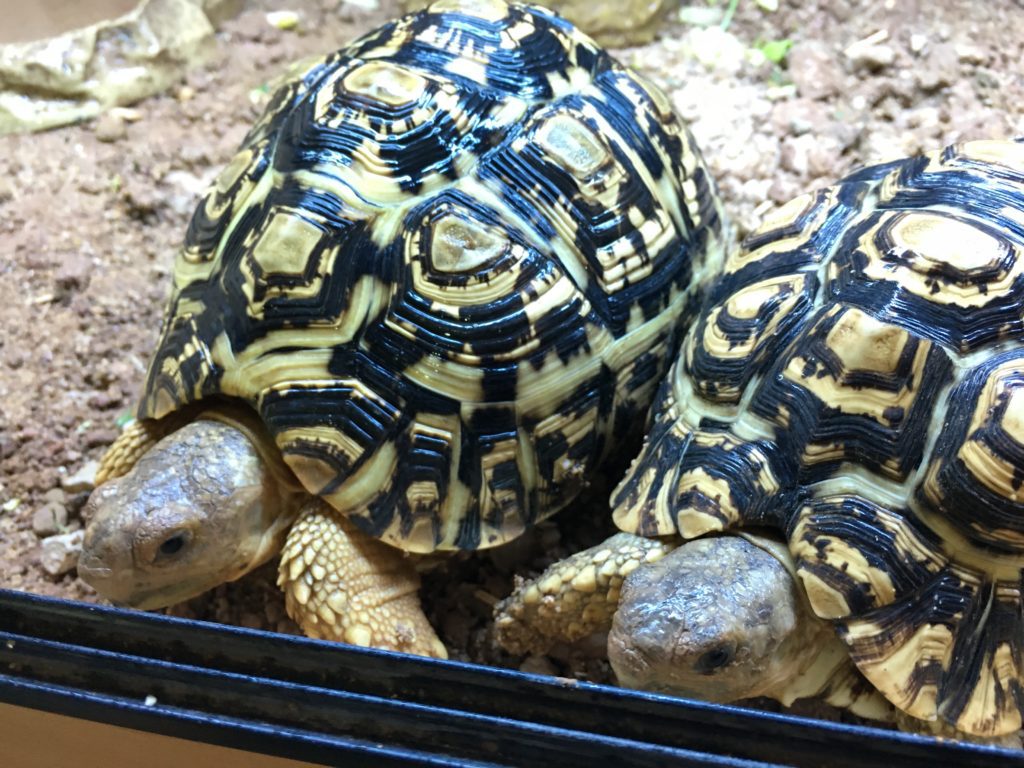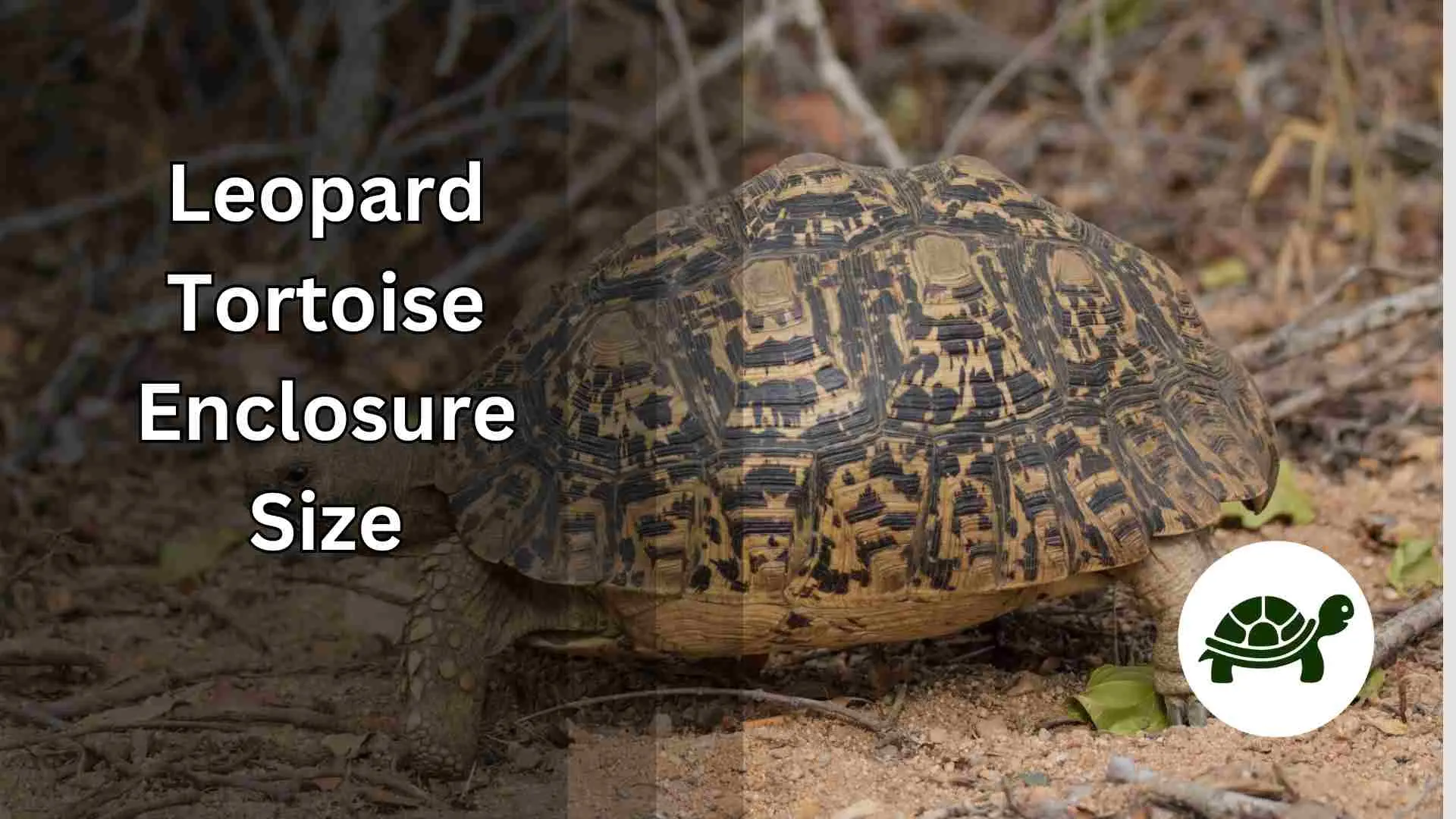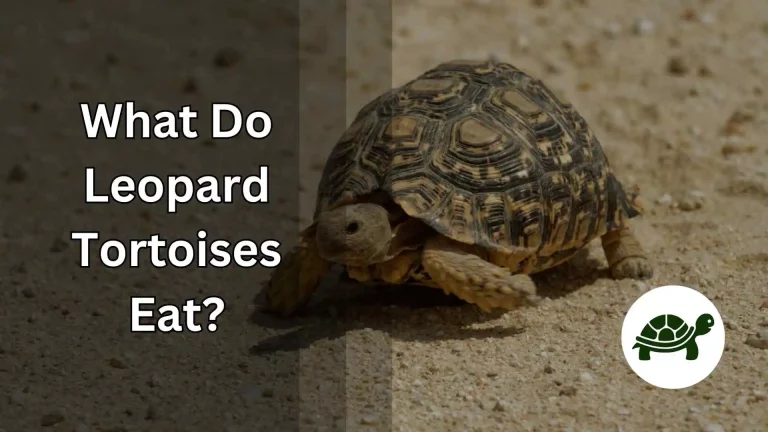Leopard Tortoise Enclosure Size – All You Need To Know
The Leopard Tortoise, celebrated for its distinctive spotted shell and tranquil temperament, holds a special place in the hearts of reptile enthusiasts. Originating from the sprawling savannas and grasslands of sub-Saharan Africa, this extraordinary creature beckons us to embark on a journey of meticulous care, urging us to recreate its native habitat in our efforts to ensure its thriving existence. Amidst this endeavor, one pivotal factor emerges as the cornerstone of our commitment: the enclosure size. Beyond its surface appearance, this dimension encapsulates a profound role in nurturing both the physical vitality and emotional well-being of these gentle giants.
In the intricate web of nature, Leopard Tortoises would once traverse vast expanses, navigating the grassy terrain in pursuit of sustenance and shelter. The expanse of their environment wielded a direct influence over the quality of their lives. As devoted tortoise enthusiasts and prospective caregivers, we inherit a responsibility that transcends words—an unspoken promise to furnish these beings with the existence they rightly deserve.
The significance of comprehending the intricate interplay between Leopard Tortoises and the space they inhabit is the crux of our commitment. It is the dedication to replicate, as faithfully as possible, the boundless and enriching landscapes they would naturally encounter in the wild. In doing so, we do more than provide a mere enclosure; we grant them a cherished slice of nature, seamlessly integrated into the fabric of our own homes.
Understanding the Leopard Tortoise’s Space Needs

Leopard Tortoises are not just any ordinary pets. They’re unique, growing steadily throughout their lives. While a baby tortoise might fit snugly in the palm of your hand, adults can reach a hefty size of up to 18 inches in length!
But why does space matter so much? For starters, these tortoises love to roam. In the wild, they’d wander vast expanses in search of food. A spacious enclosure lets them exhibit natural behaviors, ensuring they remain active and happy.
Moreover, confining them to tight spaces can harm their health. Without room to move, they can become stressed, potentially leading to ailments or reduced lifespan. Always remember: a happy tortoise is an active one. Giving them ample room is the first step in ensuring their contentment.
Indoor Enclosure Dimensions
Let’s dive into the world of indoor enclosures for Leopard Tortoises. Setting up inside? It’s vital to get the size right. These aren’t tiny turtles; they need room to roam!
Baby and Juvenile Tortoises
Starting with the little ones, a young Leopard Tortoise will need a space of at least 3×2 feet. But remember, they grow fast! It’s wise to plan ahead.
Adult Tortoises
As they mature, the space requirement grows too. An adult Leopard Tortoise deserves an enclosure that’s at least 6×4 feet. This gives them the freedom to move, explore, and stay active.
But size isn’t everything. Ensure the enclosure has hiding spots, climbing areas, and a variety of textures. These additions make the space more than just a cage—it becomes a home.
Outdoor Enclosure Dimensions
Thinking of going outdoors? Great choice! Leopard Tortoises thrive in natural sunlight. But there’s more to it than just placing them outside.
Benefits
Outdoor enclosures offer fresh air, sunlight, and a taste of nature. This can be a game-changer for a Leopard Tortoise’s health and mood.
Size Matters
An outdoor space should be generous. Aim for at least 10×10 feet for adult tortoises. The more space, the better!
Security First
While enjoying the outdoors, safety is key. Ensure the enclosure has a secure perimeter. Watch out for potential predators or escape routes.
Shade and Shelter
The sun is great, but too much isn’t. Provide shaded areas and shelters. This ensures your tortoise can cool down and hide when needed.
Remember, an outdoor enclosure is more than just a space—it’s a mini ecosystem. Set it up right, and your tortoise will thank you!
Essential Components of a Healthy Enclosure
Creating the perfect home for your Leopard Tortoise? It’s more than just size. Here are the must-haves for a happy, healthy tortoise home:
Substrate Choices
Think of it as the floor of their home. Coco coir, cypress mulch, and orchid bark are great picks. They’re soft, safe, and easy to clean.
Decor Time
Plants, rocks, and hides make an enclosure lively! They provide natural hiding spots and keep your tortoise entertained.
Water Wonders
A shallow water dish is a must. It’s for drinking and soaking. Just ensure it’s easy for your tortoise to climb in and out.
Light and Heat
Tortoises need sunlight, especially UVB. Not getting natural sun? UVB lights are essential. And don’t forget a heating lamp for those cooler days. Check Tortoise Lightning Setup for more info.
Humidity Control
A mister can help maintain the right moisture levels. Remember, it shouldn’t be too dry or too wet. Just right!
The perfect enclosure is a mix of the right size, decor, and conditions. With these essentials, you’re on track to create a tortoise paradise!
Common Mistakes to Avoid
Setting up a tortoise home? Watch out! Even with the best intentions, some mistakes can creep in. Let’s tackle the top pitfalls:
Tight Spaces
Leopard Tortoises need room! A tiny enclosure can stress them out. Always prioritize space, especially as they grow.
Wrong Temps
Too hot or too cold, both are bad. Monitor temperatures. Investing in a good thermometer is a game-changer.
Unsafe Plants
Not all greens are good. Some plants can be toxic to tortoises. Always research before adding any new plants. Know more about plants in enclosure visit “Best Plants for Tortoise Enclosure”
Poor Lighting
UVB lights are essential. A lack of UVB can lead to health problems. Make sure their light setup is on point.
Bad Substrate
Sand or cedar chips? Big no-nos. They can cause respiratory or digestive issues. Stick to safe substrates like coco coir.
Avoiding these mistakes sets the foundation for a happy, healthy tortoise life. With a bit of care and knowledge, you can create the ideal home!
Adapting Enclosure Size as Your Tortoise Grows
Tortoises grow, and so should their space! It’s like upgrading from a kiddie bed to a king-size. Here’s how to keep up:
Spotting the Signs
Is your tortoise trying to climb the walls? Maybe it’s time for more room. Keep an eye on their behavior.
Baby to Juvenile
That cute tiny tortoise won’t stay small forever. When they start growing, expand their space. Be ready to upgrade.
Juvenile to Adult
This is the big leap. An adult Leopard Tortoise needs much more space. Think ahead and plan for the switch.
Modular Designs
Consider enclosures that can expand. It’s like adding rooms to a house. Makes growing up a smoother ride!
Remember, adapting the enclosure is a sign of love. It shows you’re tuned in to your tortoise’s needs. Keep adapting, and they’ll thrive!
Frequently Asked Questions (FAQs)
1. How often should I clean my Leopard Tortoise’s enclosure?
A clean home is a happy one! Spot clean daily for waste and do a deep clean once a month. This keeps the environment fresh and disease-free.
2. Can I house multiple Leopard Tortoises together?
Yes, but with caution. Ensure the enclosure is spacious enough for all. Monitor for signs of aggression or bullying to keep the peace.
3. What’s the ideal temperature for a Leopard Tortoise enclosure?
Aim for a basking spot of around 90°F and a cooler area around 75°F. Use thermometers to keep track and adjust as needed.
Q4. Do Leopard Tortoises hibernate?
Unlike some tortoises, Leopard Tortoises don’t truly hibernate. But they might slow down in cooler temperatures. Keep their environment stable to prevent this.
Q5. Can I use regular tap water for my tortoise’s water dish?
Ideally, use dechlorinated water or let tap water sit for 24 hours before using. This ensures any harmful chemicals evaporate.
Conclusion
In the realm of Leopard Tortoise care, the commitment goes far beyond the routine rituals of daily feedings or sporadic health assessments. It delves deeper, into the very essence of the environment they call home. The enclosure, meticulously designed to match their natural habitat, emerges as a pivotal cornerstone in nurturing their overall well-being. It’s not just about physical dimensions; it’s about creating a haven that nurtures their body and spirit.
As fervent tortoise enthusiasts and caretakers, we hold in our hands the power to sculpt their world. By ensuring the enclosure is adequately sized and thoughtfully equipped, we are, in essence, laying the groundwork for a lifetime of health, happiness, and contentment for these majestic creatures. Our responsibility transcends the boundaries of brick and glass; it extends to replicating, as closely as possible, the vast and enriching expanse they’d encounter in the wild. In doing so, we endow them with more than just shelter; we bestow upon them a precious slice of nature, right within the confines of our homes.


